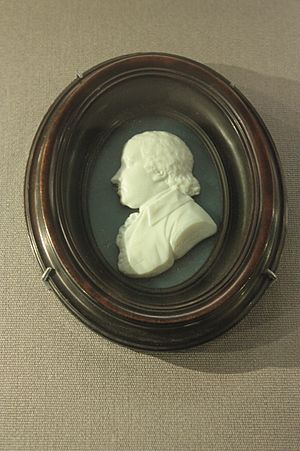Benjamin Bell facts for kids

Benjamin Bell (born September 6, 1749 – died April 5, 1806) was a very important Scottish surgeon. Many people call him the "father of Edinburgh surgery." This means he helped create the way surgery was taught and practiced in Edinburgh. He wrote a famous book called A System of Surgery. This book was a bestseller across Europe and America.
Bell's most important idea was to "save skin" during operations. This helped wounds heal much better. He also believed in giving patients pain relief during and after surgery.
Contents
Early Life and Learning
Benjamin Bell was born in Dumfries, Scotland, on September 6, 1749. He was the oldest of 15 children. His father, George Bell, was a farmer. The family had some money, which helped Benjamin later in life. It allowed him to travel and study. He went to Dumfries Grammar School for his early education.
Becoming a Surgeon
Benjamin Bell started learning surgery as an apprentice to James Hill in Dumfries. In 1766, he moved to Edinburgh to study medicine at Edinburgh University. He learned from famous teachers like Alexander Monro, a specialist in how the body is built (anatomy). He also learned from Joseph Black, a chemist, and John Hope, a botanist.
In 1767, he became a "dresser" in the surgical wards. This meant he helped with patients' wounds. Two years later, he became a "surgeons' clerk."
Learning Abroad
Bell visited London and Paris to learn more about surgery. He wrote to his father that Edinburgh was great for doctors. But for surgeons, London and Paris were much better. He met John Hunter, a famous surgeon in London. Bell said Hunter was "the most agreeable and at the same time the most useful acquaintance I ever met with." He also learned from another London surgeon, Percivall Pott.
In 1770, after passing his exams, he became a surgeon-apothecary. This was part of the group that later became the Royal College of Surgeons of Edinburgh.
His Work as a Surgeon
When Bell returned to Edinburgh, he started his own surgical practice. At just 24 years old, he became one of the main surgeons at the Royal Infirmary of Edinburgh. He worked there for 18 years, which was a very long time.
A Time to Write
In 1775, Bell fell from a horse and was injured. He had to stop working as a surgeon for about two years. This break was actually good for him. It gave him time to think and write. Because his family had money, he didn't have to worry about earning money during this time. He also rented a farm called Liberton Farm. This helped him develop his interest in farming.
A Successful Practice
After his injury, Bell returned to surgery. He became partners with other surgeons, including James Russell. Their practice became one of the most important in Scotland. Another surgeon, John Campbell, said that "no one could die contented without having consulted Benjamin Bell."
In 1783, Benjamin Bell helped start the Royal Society of Edinburgh. This was a group for important scientists and thinkers.
He passed away in Edinburgh in 1806. He is buried in Canongate Churchyard in Edinburgh.
Bell's Big Ideas in Surgery
Benjamin Bell is known as the first "scientific surgeon" in Scotland. This is because he used clear, logical thinking in his medical writings. His most famous work was his textbook, A System of Surgery.
A System of Surgery
This important book came out in six parts between 1783 and 1788. It was very popular and was printed seven times by 1801. It was also translated into Italian, French, Spanish, and German. It was popular because it covered everything about surgery. It also used the newest information from all over Europe.
Bell strongly believed in using opium to help patients with pain after surgery. He wrote that being able to ease pain for those having operations "must afford the biggest gratification to every practitioner."
Family and Legacy
Benjamin Bell married Grizel Hamilton in 1774. They had several sons who became important in Edinburgh. His son, George Bell, was even the official surgeon to King George IV when the king visited Scotland.
The Bell Surgeon Family
Benjamin Bell started a long line of famous surgeons in Edinburgh. His son Joseph, grandson Benjamin, and great-grandson Joseph (1837–1911) were all surgeons. They all became presidents of the Royal College of Surgeons of Edinburgh.
His great-grandson, Joseph Bell, was especially famous for his amazing ability to notice tiny details. He could use these details to figure out what was wrong with a patient. This skill inspired a young medical student named Arthur Conan Doyle. Doyle used Joseph Bell as the model for his famous detective character, Sherlock Holmes.
Images for kids






